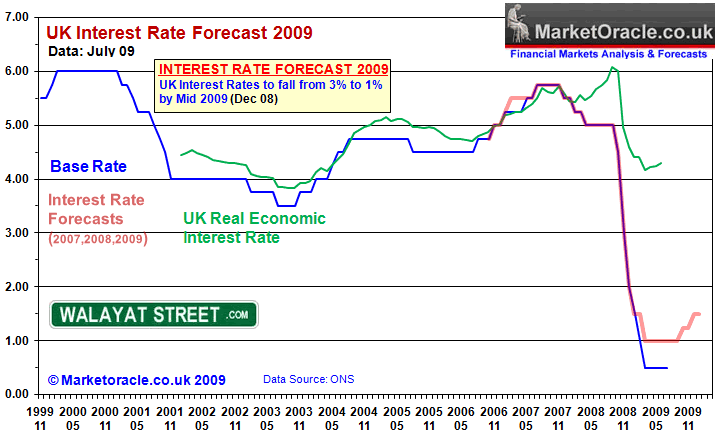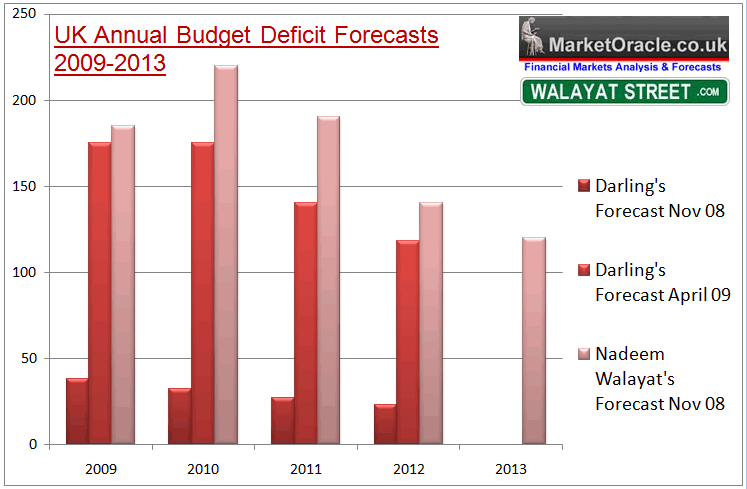UK Interest Rates Forecast to Crash to 1%
Interest-Rates / UK Interest Rates Dec 04, 2008 - 02:13 AM GMTBy: Nadeem_Walayat

 Gordon Browns government having abandoned all of the fiscal rules that it once prided itself on religiously following, is now hell bent on kick starting the UK economy in advance of the looming May 2010 general election deadline. The steady as she goes economic policy has been replaced by the panicking 'unprecedented action's' economic policy and in that having rested away control of UK interest setting from the Bank of England in all but name, UK interest rates are now set to be the latest to take a crash course towards an unprecedented level of just 1%.
Gordon Browns government having abandoned all of the fiscal rules that it once prided itself on religiously following, is now hell bent on kick starting the UK economy in advance of the looming May 2010 general election deadline. The steady as she goes economic policy has been replaced by the panicking 'unprecedented action's' economic policy and in that having rested away control of UK interest setting from the Bank of England in all but name, UK interest rates are now set to be the latest to take a crash course towards an unprecedented level of just 1%.
The Path to the Crash in UK Interest Rates - UK Housing Market Crash of 2007-2008
The housing market started the crash ball rolling as the interbank money markets first froze in August 2007 as financial intuitions were no longer able to accurately price and trade their U.S. subprime mortgage backed securities that led to an increase in the risk of default that soon spread to non subprime related derivatives, to an active derivatives trader this clearly spelled doom for the UK housing and implied an imminent downtrend in house prices, the magnitude of which was originally estimated to be at least at the rate of 7.5% per annum.
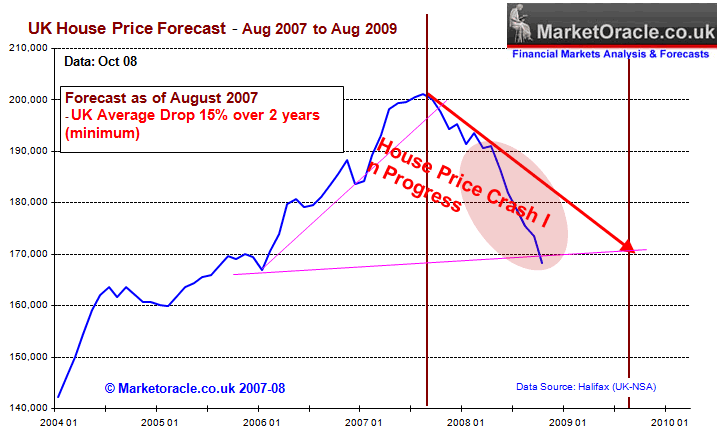
At the time the regulator (FSA) and Bank of England and the government failed to take any effective action which resulted in the first banking crash of 2007, when Northern Rock went bust by triggering a humiliating first run on a British bank in some 150 years. There could not have been a clearer confirmation of the end of an era for the British housing and easy money markets, and which suggested that house prices would decline at an even faster rate.
The August 07 credit crunch clearly signaled much lower interest rates, with my subsequent forecast of September 2007 targeting UK interest rates to fall to 5% by September 2008 at a time when the majority were still looking for UK interest rates to rise to above 6% (5.75% at the time).
However, despite the next few months bringing soothing voices from amongst the vested interests in a stable housing market such as forecasts of no falling house prices during 2008, but rather a soft landing much as transpired during the early years of the 1989-1992 housing bust. House prices confirmed the August peak and continued trending lower at the rate of 7.5% per annum. However the credit crisis continued to intensify as the interbank LIBOR rate leapt to a new credit crisis extreme, still the authorities failed to recognise the extent of the problem in that the banks had hidden the true extent of their growing losses and exposure to the U.S. subprime mortgage market off the banks balance sheets that effectively put them most at risk of insolvency.
By November 2007, the growing signs of an impending crash in the UK housing market was anticipated to occur starting in April 2008 to coincide with the Capital Gains tax changes that would induce buy to let speculators making a mad dash for the exit.
Finally by December 2007, the Bank of England made its first interest rate cut of 0.25%, whilst at the same time starting to recognise that interbank market was not functioning and started to make short-term loans that were added to for longer-terms later in the year by the UK treasury in April 2008, however by that time it was too late as the housing market crash of 2008 had begun.
However after the rate cut of May 2008 to 5%, the Bank of England who's primary goal is to target inflation at 2% CPI, became paralysed by the fear of inflation as CPI inflation busted through the 3% upper boundary all the way to the 5.2% peak in October 2008. The BoE remained paralysed into inaction for the whole period, when the BoE had the opportunity to act it failed to do so, which resulted in an acceleration in the housing market rate of decline to twice the anticipated rate and soon followed by the UK economy falling off the edge of the cliff as an increasingly worried Gordon Brown watched on in horror as his chances of winning the next general election quickly evaporated.
It is not as though the BoE did not have any warning that inflation would soon reverse given the peak in Crude Oil in July at $147, which at that time my analysis called for an imminent peak and for oil prices to trend lower towards a target of $80, later with crude oil hovering at $90 my analysis concluded that crude oil would overshoot to the downside towards $60. However despite the peak in Crude oil, the Bank of England did nothing at subsequent meetings to cut interest rates but remained frozen into inaction.
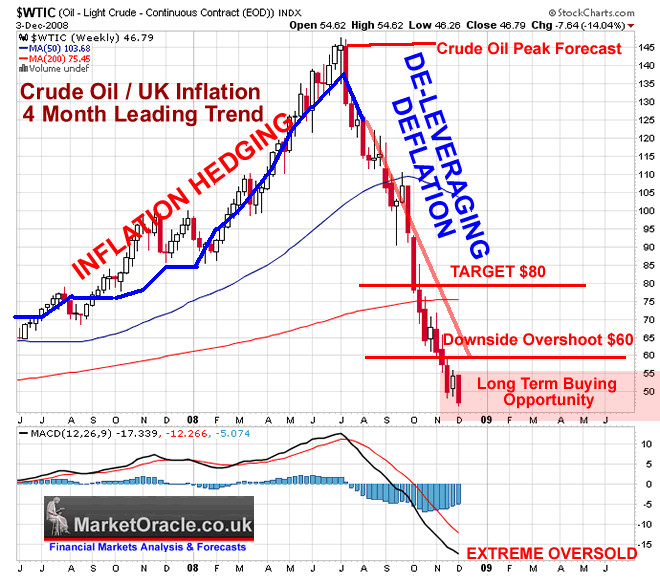
It took emergency action by the Government to effectively rest control of monetary policy away from the BoE by cutting interest rates by 0.5% as announced not by the Bank of England but a day earlier by Gordon Brown at the Prime Ministers Dispatch box, which sent a clear message to the markets that Gordon Brown had now taken over control of monetary policy due to the lack of action by the Bank of England during the preceding 3 months or so. The emergency action did not end there, the dual emergency action also involved an unprecedented £500 billion bank rescue scheme in an attempt at repairing the damage to the Britain's Banking System due to the failure to regulate the banking system that had contributed to bringing the UK financial system to the brink of collapse.
The October 0.5% rate cut was later followed by the panic 1.5% rate cut in November as the Bank of England played catchup in attempt to repair the damage done as a consequence of inaction during the preceding months.
UK Housing Market, Inflation and Debt Forecasting Uncertainty
The consequences of the systemic mismanagement of UK financial system is that the ever escalating measures taken to turn the economy around will prove highly costly to Britain for many years in terms of loss of real value of asset values and disposable incomes as the debt burden and liabilities soar to beyond £3.2 trillions. This also creates a great deal of uncertainty and difficulty in generating forecasts, because it is unknown to what extent the governments liabilities will actually grow to. The recent analysis - Bankrupt Britain Trending Towards Hyper-Inflation? , highlighted the dangers that the banking sector posed to the UK economy with the risks that should a wholesale nationalisation of the banks be required then that would lift total liabilities to the British tax payer by £5 trillion, in comparison to the £500 billion of official public sector net debt outstanding at the end of 2007. This extra liability would be on top of the deficit spending and borrowing binge that the government announced in the emergency budget and thus risked bankrupting Britain which would be manifested in a collapse in the currency and thus the inability of Britain to service debt denominated in foreign currencies. For the updated housing market forecast covering the next 2-3 years subscribe to our free newsletter.
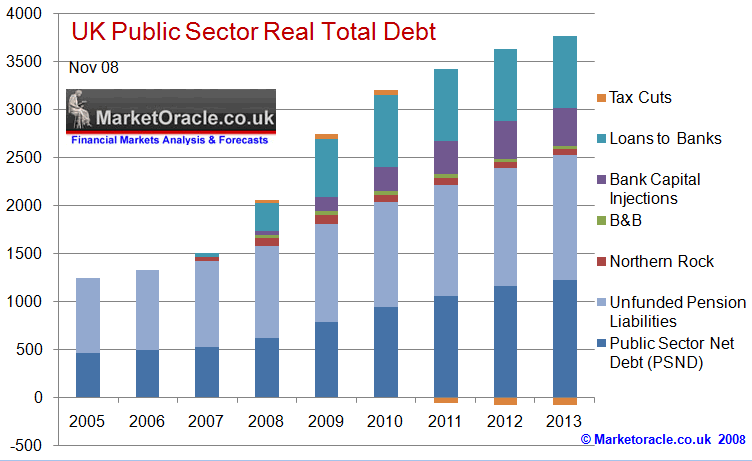
UK Economic Contraction and Deflation
The UK economy is expected to contract by at least 3% for the period to the end 2009. This contraction coupled with the slump in asset prices is highly deflationary and expected to lead to a sharp fall in the rate of UK inflation into Mid 2009. However deflation will be short lived and my expectations are for a V shaped bottom and for inflation to resume and trend towards 2% CPI by early 2010, which suggests ultra low interest rates will not stay around for long and follow inflation higher by the end of 2009.
Whilst deflation has yet to show in the inflation statistics, however it is apparent in the retail sales trend and inflation adjusted data which illustrates a slump in retail sales activity that is contracting at the rate of -1.8% year on year and reflects the actual state of the retail sales market. This trend is expected to continue deteriorating for the duration of the recession as more retailers report losses and in fact go out of business.
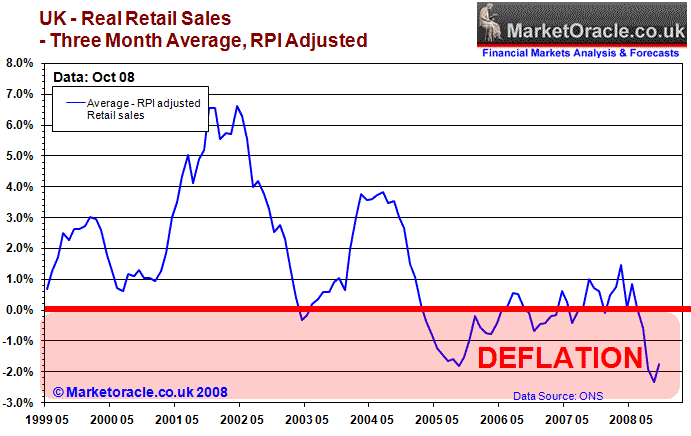
British Pound Inflationary Crash
Sterling has already fallen by 30% against the US dollar, this means goods in the shops are 30% cheaper for Americans, and 22% cheaper for Europeans, this disparity is not going to hold for much longer especially as my long range forecast is for sterling to trend down towards the £/$137.50 multi decade support level which may give temporary respite to the sterling bear market. However a break below £/$137.50 would target parity to the US Dollar, which will mean a further loss of value of 35% in the value of all assets and 53% loss of value for the duration of the bear market to parity and likewise a large rise in the price of dollar imported commodities, goods and services and to a lesser degree from other countries, therefore highly inflationary. Therefore this confirms that goods in the shops won't remain cheap for long and thus shoppers should take the opportunity to buy now as the price for filling shop stocks later in 2009 will be significantly higher.
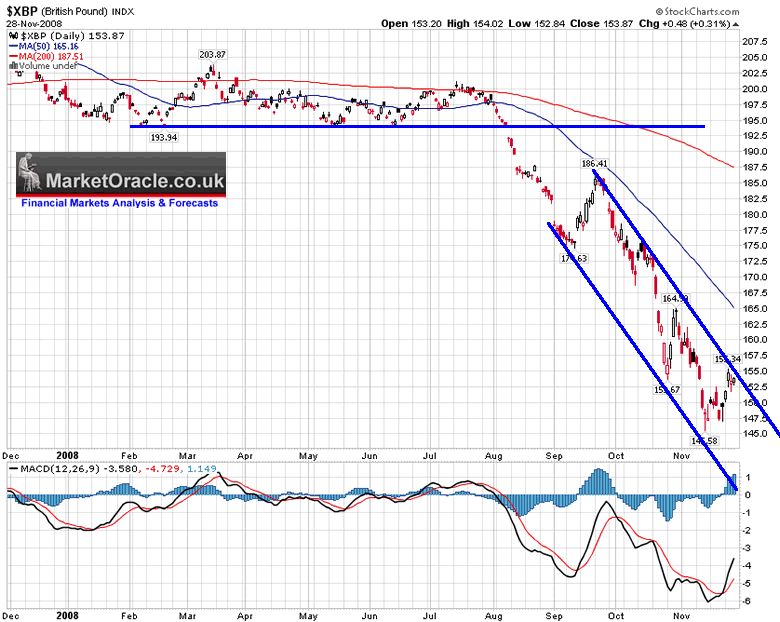
LIBOR
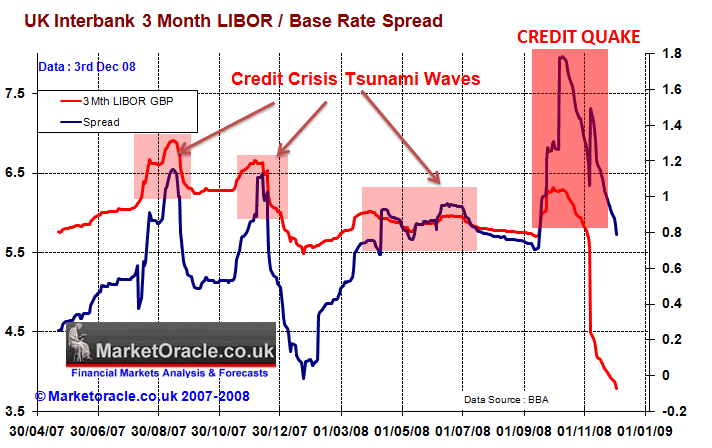
The LIBOR interbank rate continues to ease from credit quake extremes, bringing the spread between the base rate and the LIBOR rate to below 1% and on target to achieve the pre-credit crisis spread rate of less than 0.75% above the base rate. However a rate cut today will temporarily lead to a widening in the LIBOR spread as the market will take some weeks to adjust to the rate cut.
UK Interest Rate Forecast
The race is on to keep cutting UK interest rates towards ZERO before inflation takes off. However as I pointed out earlier the UK government has the advantage for at least another 6 months due to the extent of economic contraction and the expectations for a sharp fall in inflation which projects to significantly below the 2% target rate, and in fact the RPI measure may even go negative next year i.e. real deflation. This gives the Bank of England ample time and scope to make further deep interest rate cuts. However the clear signal from the government is take the action now, rather than later so the pattern of drip, drip rate cuts that had been the norm up until November is now no longer official monetary policy. The policy now is to shock the UK economy into a turnaround, for the sooner the economy bounces back the sooner the general election will be called. Therefore there is a high probability that UK interest rates will be cut by 1% later today to take UK interest rates down to 2%, which will be a brief marker enroute towards taking interest rates to possibly below 1%, though probably making a low at 1% by early next year and staying there for some months as the below graph illustrates.
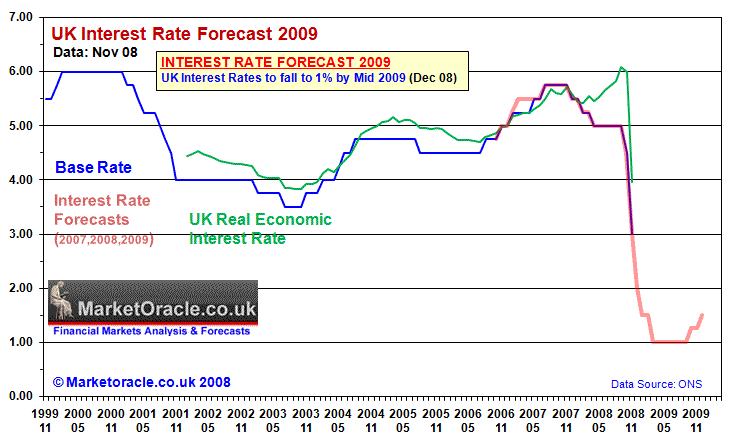
Savers Pay the Price
Today's base rate cut to perhaps 2% would leave typical better paying instant savings accounts in the region of 2.5% to 3%, whilst above the base rate these are still a good 1.5% to 2% below the current inflation rate of 4.5% and therefore savers are losing as much as 2% of the value of their savings in real terms and therefore savers are paying the ultimate price for the credit crisis bailouts and government debt fuelled electioneering spending spree. This is even more so when the 20% to 30% currency crash is taken into account which has wiped away significant purchasing power of the British Pound in everyone's pocket. The ultimate outcome is for the exploding debt burden to ensure stagflation for many years following the deflation of 2009.
By Nadeem Walayat
http://www.marketoracle.co.uk
Copyright © 2005-08 Marketoracle.co.uk (Market Oracle Ltd). All rights reserved.
Nadeem Walayat has over 20 years experience of trading derivatives, portfolio management and analysing the financial markets, including one of few who both anticipated and Beat the 1987 Crash. Nadeem's forward looking analysis specialises on the housing market and interest rates. Nadeem is the Editor of The Market Oracle, a FREE Daily Financial Markets Analysis & Forecasting online publication. We present in-depth analysis from over 150 experienced analysts on a range of views of the probable direction of the financial markets. Thus enabling our readers to arrive at an informed opinion on future market direction. http://www.marketoracle.co.uk
Disclaimer: The above is a matter of opinion provided for general information purposes only and is not intended as investment advice. Information and analysis above are derived from sources and utilising methods believed to be reliable, but we cannot accept responsibility for any trading losses you may incur as a result of this analysis. Individuals should consult with their personal financial advisors before engaging in any trading activities.
Attention Editors and Publishers! - You have permission to republish THIS article. Republished articles must include attribution to the author and links back to the http://www.marketoracle.co.uk . Please send an email to republish@marketoracle.co.uk, to include a link to the published article.
Nadeem Walayat Archive |
© 2005-2022 http://www.MarketOracle.co.uk - The Market Oracle is a FREE Daily Financial Markets Analysis & Forecasting online publication.
Comments
|
Tom
05 Dec 08, 07:11 |
UK Economy Unfolding events
As I observe the unfolding events in our county`s economy I have become more and more convinced that the so call elites running the various "shows" are devoid of any common sense.
I spoke to someone in Halifax when it was first rumoured they had a problem. The lady was most insistent there we no real problem to worry about. She even showed me the e-mail that had been sent to all staff. It ended "You can tell all customers their savings are safe with Halifax". If I remember correctly he was the chap who got the chop some weeks later.
As I pointed out at the time he was hardly going to say "Grab your money and run".
I am grateful to be retired and have no mortgage, unlike many others who I suspect are going to face much harder time than me in the coming months and years.
Keep up the good work.
Kind regards, Tom Odell. |
|
|
Steve Higgins
05 Dec 08, 07:13 |
Central Banks
I enjoyed your article today, as always. I would like to disagree with you on one major point. I do not agree that the BofE did the wrong thing not cutting rates fast enough per your timeline. Instead, this is how I see it: 1) there should be no Fed in the US and no BofE or Central Banks worldwide. THEY ARE THE PROBLEM. They are the cause of all this. (If you aren’t aware of this and would like more proof, please let me know and I will be happy to share that with you). Like most, we often forget this and start speculating on treating symptoms by guessing what the Central Banks should or should not have done, when the fact is there should be no THEM to do anything at all. 2) I feel strongly that given that we are in prison, enslaved to the Fed, then here is what the BofE should have done: Raised rates dramatically. Now, you probably first think I am out of my mind. I assure you, I am not! Look what has happened in the US. as Prima Facie evidence. They have dramatically cut rates and the problem is worse, keeps getting worse by day, will be worse next month, etc. That is because lower rates are the CAUSE of the problem, right alongside with the ability to control (manipulate) interest rates. HIGHER rates would have immediately caused: 1) break the inflation that definitely existed at that time 2) curtail spending by consumers, who would not dare add more debt at much higher rates (savings, not spending is the magic forgotten formula) 3) caused bank failures, a blessing. many banking jobs would have been lost, a good thing, as they are useless jobs anyway involving transfer of wealth to Feds in the end 4) FDIC insurance in the US would have caused the government to step up – not to save bankers – but to cover the depositors (citizens!!) to be made whole – having the effect of not further stressing the consumer. Having almost lost their money, citizens risk appetite would have decreased dramatically 5) Savings would occur, a major positive 6) House prices would have crashed quickly to correct levels, creating more affordable housing – what a novel concept!! 7) Capital formation would begin – as the higher rates would lead to higher savings, investment and eventually more jobs and a resurgence in the economy
So, if BofE had RAISED rates when the US had started lowering they would have IMPROVED their competitive position for the medium and longer term and the short term pain would have been excellent medicine instead of the heroin fix that a cut in rates would have provided, then provided again, then provided again, then provided again… Consumers would have stopped spending and started saving and working harder to pay off bills. Believe it or not, the last thing anyone needed worldwide was MORE credit. Persistent rate cutting DESTROYS jobs and economies. Did you see the FinlSense writeup last week? Here it is: http://www.financialsense.com/editorials/fekete/2008/1201.html We will never know for sure, of course, because the Fed or BofE do exist, and they will always follow Keynesian claptrap, because IT PADS THEIR POCKETS! But this too will change – in America we are seeing a huge surge in END THE FED sentiment. It is growing because that is what is needed – freedom from usury slavery. Ya, the BofE will cut rates to 1% or lower, destroying the currency and the economy and the country, which is why I’ve been short the pound for months J But only worse than the US because the dollar has the advantage of being a Reserve currency. Just wanted to share my two cents. I respect your thoughts and thank you for your writeup. Best Regards, Steve Higgins Boulder, Colorado, USA |
|
|
Nadeem_Walayat
06 Dec 08, 13:15 |
UK Interest rates
Hi Steve The purpose of the analysis was to forecast what the Bank of England is expected to do i.e. cut interest rates, and not what I would have done since the crisis broke last year. The original forecast was for rates to be cut to 3.25%, but the bank failed to act which has resulted in panic measures that are destined to take UK interest rates to 1% that will result in many years of stagflation following deflation, so not a great place to be invested until public sector spending is brought under control. I agree with many of your points which I mentioned in an earlier article of what Britian should be doing rather than what it will be doing - http://www.marketoracle.co.uk/Article7526.html I turned bullish on the US Dollar in March 2008 - http://www.marketoracle.co.uk/Article4072.html and have remained so, the article in october highlighted some of the reasons why the dollar was in a bull market http://www.marketoracle.co.uk/Article6985.html, the dollar bears may be truly in for a shock as the US will be the FIRST economy to come out of the current recession and therefore expect much more dollar strength. Offcourse there will be significant corrections, but the dollar trend is UP. Best. Nadeem Walayat, |
|
|
Nadeem_Walayat
08 Jan 09, 22:03 |
UK Interest Rates Cut to New All Time Low of 1.5%
The Bank of England cut UK interest rates earlier today by 0.5% to 1.5%, the lowest that the base rate has been in the BoE's 315 year history. The series of rate cuts are a belated panic response to the UK economy plunging over the edge of a cliff that looks set to endure GDP contraction of 3% this year which is worse than any 12 month period since World War 2. Sterling rallied from near record lows against the Euro buoyed by a less than expected cut as many market commentators had expected rates to be cut by 1% today.
The interest rate cut of 0.5% for January is inline with my forecast for interest rates to target a fall to 1% by mid 2009 as the above graph illustrates. However given the deteriorating state of the UK economy there is a risk that rates could overshoot to the downside during mid 2009 by falling below 1%. As the credit markets have frozen the real economic rate has become far less responsive to base rate cuts, therefore the latest cut is expected to make very little difference to the severity of the recession, thus the buzz word for 2009 is "Quantative Easing" which basically means printing money, the consequences of which will be much higher inflation as we come out of economic contraction. I have avoided referring to the Bank of England's accompanying statement due to the fact that it is basically meaningless drivel that seeks to put the blame of failure to regulate the banking sector and manage UK monetary policy competently onto the backs of "global forces". Unfortunately the government has proved just as incompetent in its handling of the crisis, which includes the £20 billion or so flushed down the toilet in the form of the 2.5% cut in VAT that has had NO EFFECT on the high street. Not to mention the £600 billion of liabilities of the banking sector which rivals the official public sector debt of £600 billion and hence contributed to sterling's recent 30% crash. The UK economy is heading for real deflation as the UK inflation forecast for 2009 concluded, with the RPI measure is expected to go negative and target -1.2% by July 2009.
Deflation is already evident in the high street as the debt fueled long consumer boom has come to an end and claims major high street names each week, with last of Woolworth stores having closed earlier this week.
UK house prices continued to crash lower, with the latest data from the Halifax showing average house prices falling by £4,400 in December. The house price data is inline (-0.5% deviation) with the recently updated house price forecast that covers the trend into 2012 that projects for a total drop from peak to trough of 38%, with a 16% drop in house prices targeted for 2009 to be followed by a sustained depression for several years thereafter as the below graph illustrates.
My next newsletter will cover analysis of the major investment trends for financial markets for 2009. To receive this on the date of publication subscribe to my always free newsletter. By Nadeem Walayat Copyright © 2005-09 Marketoracle.co.uk (Market Oracle Ltd). All rights reserved. Nadeem Walayat has over 20 years experience of trading derivatives, portfolio management and analysing the financial markets, including one of few who both anticipated and Beat the 1987 Crash. Nadeem's forward looking analysis specialises on the housing market and interest rates. Nadeem is the Editor of The Market Oracle, a FREE Daily Financial Markets Analysis & Forecasting online publication. We present in-depth analysis from over 150 experienced analysts on a range of views of the probable direction of the financial markets. Thus enabling our readers to arrive at an informed opinion on future market direction. http://www.marketoracle.co.uk Disclaimer: The above is a matter of opinion provided for general information purposes only and is not intended as investment advice. Information and analysis above are derived from sources and utilising methods believed to be reliable, but we cannot accept responsibility for any trading losses you may incur as a result of this analysis. Individuals should consult with their personal financial advisors before engaging in any trading activities. |
|
|
Nadeem_Walayat
09 Jul 09, 07:33 |
UK interest rates 2009 - Update
Irrelevant UK Base Interest Rate on Hold as Real Rates have Already Begun to Rise
The existing base interest rate forecast as of December 2008 is for UK interest rates to resume an upward curve towards the end of this year as a consequence of the debt fuelled economic recovery into a projected May 2010 General Election as illustrated by the below graph. UK interest rates hit bottom in March 2009 with the subsequent trend to date inline with the expectation for unchanged rates well into the second half of 2009 with the first rate rise forecast to occur at the October 2009 meeting.
Whilst the base interest rate is at a record low of 0.5%, however the real economic interest rate remains stubbornly high at above 4% and has already started to rise which is reflected in the experience of borrowers that are starting to see significant rise in the interest rate charged by the tax payer bailed out banks, this is set against a LIBOR money market interest rate that continues to fall as the credit crisis eases which has seen LIBOR now fall to 1.18% from 1.65% 3 months ago. Government Borrowing and Quantitative Easing The Bank of England has already printed near £125 billion of money so as to buy mainly government bonds in response to the huge budget deficit that the Labour government will rack up by the end of this year that projects to £180 billion against the Labour governments estimate of £38 billion in November. The outlook for subsequent years also remains for bleak with deficits expected to continue for many years as Alistair Darlings own forecast for government net borrowing over the next 4 years has grown from a deficit of £120 billion in November 2008 to £608 billion as of the budget, which is still significantly below my forecast total of £735 billion and therefore the expectation remains for further revisions to the upside over the coming years. This confirms my view that the Bank of England will continue printing money into year end to beyond the current arrangement. Which on face value is both inflationary and artificially supportive of the economy, i.e. there will be a day of reckoning for unrestrained money printing and borrowing that projects towards a more severe double dip recession during 2011.
Money printing to artificially reduce market interest rates has succeeded in reducing the short-term money market rates, and in holding down long-term government bond interest rates, therefore boosting the bailed out bankrupt bank balance sheets enabling them to continue paying their executives and senior staff large bonuses whilst little sign of these tax payer owned banks increasing lending to retail customers. Banks Squeezing Borrowers and Underpaying Savers As mentioned earlier, the LIBOR interbank rate continues to fall, however the rate charged to borrowers has risen markedly especially hitting mortgage borrowers as illustrated by the below data from the MoneyFacts.
Moneyfacts data is inline with my own research that typically shows an increase in the spread between lending and borrowing from 0.5% in July 2007, having now risen to an eye watering 4.5% above base rate, and 3.75% above the interbank rate. Typically the expectation is for for lenders to charge 1% above the borrowing rates, therefore the average rate should be at approx 2.7% rather than the current rate of above 5% that is being offered to borrowers who meet the tighter lending criteria today. This is as a consequence of the artificial market created as a consequence of government intervention in the form of bank bailouts, nationalisation, capital injections and bad debt insurance totaling more than £1.2 trillion. Which is enabling banks to effectively funnel tax payers cash onto their balance sheets and hence squeeze the borrowers and savers at the same time due to less supply due to lack of competition. Whereas had the bankrupt banks been allowed to go bust then the market place would have been filled with new entrants rather than bankrupt zombie banks being subsidised by tax payers and hence resulting in lack of market competition, much as occurred in nationalised industries of past. Interest Rate Outlook Conclusion The outlook remains for rising market interest rates charged to retail customers, regardless of the direction of the interbank rate and the base rate that is expected to remain at 0.5% into the October 2009 MPC Meeting. Implications for Savers and Borrowers Borrowers - Interest rates are already heading higher, the best strategy here would be to try and fix at the best rate available for as long as possible as the consequences off out of control government borrowing will be much higher interest rates. Savers - Savings interest rates remain significantly below the market lending rates, this is due to the artificial market as a consequence of bank bailouts as in effect it is the savers who are paying from the credit crisis in record low interest rates. However market forces are beginning to reassert themselves in improving savings rates, whilst this is a gradual process it does mean that gradually the huge gap between savings rates and lending rates will begin to narrow, and as lending rates are expected to rise so one can anticipate a greater rise in the savings rates going forward, therefore the strategy would be in favour of not fixing savings rate at this point in time or adopting very short-term fixes if one can obtain a good short-term savings rate i.e. above 4% for 1 year or less. To receive my in depth analysis on the UK economy, interest rates and housing market subscribe to my always free newsletter. By Nadeem Walayat Copyright © 2005-09 Marketoracle.co.uk (Market Oracle Ltd). All rights reserved. Nadeem Walayat has over 20 years experience of trading derivatives, portfolio management and analysing the financial markets, including one of few who both anticipated and Beat the 1987 Crash. Nadeem's forward looking analysis specialises on the housing market and interest rates. Nadeem is the Editor of The Market Oracle, a FREE Daily Financial Markets Analysis & Forecasting online publication. We present in-depth analysis from over 250 experienced analysts on a range of views of the probable direction of the financial markets. Thus enabling our readers to arrive at an informed opinion on future market direction. http://www.marketoracle.co.uk Disclaimer: The above is a matter of opinion provided for general information purposes only and is not intended as investment advice. Information and analysis above are derived from sources and utilising methods believed to be reliable, but we cannot accept responsibility for any trading losses you may incur as a result of this analysis. Individuals should consult with their personal financial advisors before engaging in any trading activities.
|



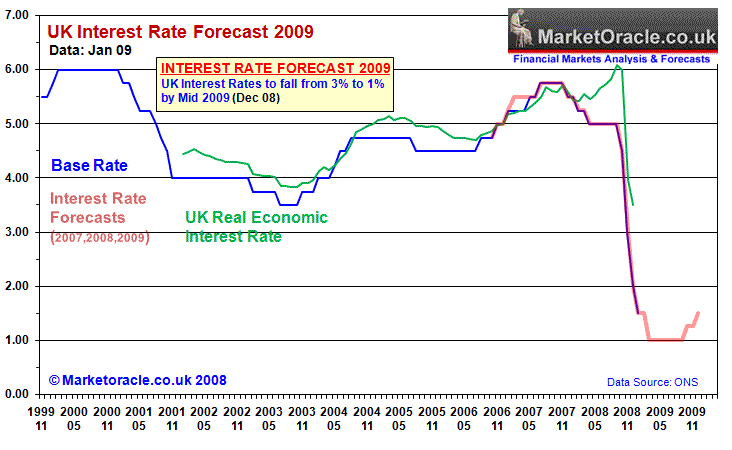
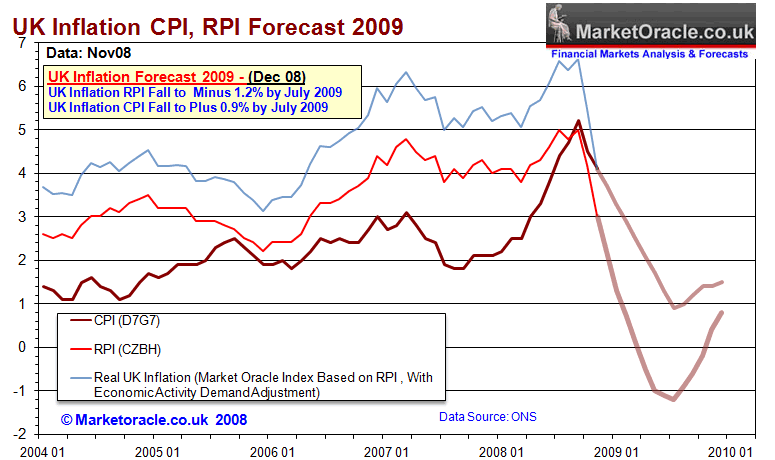

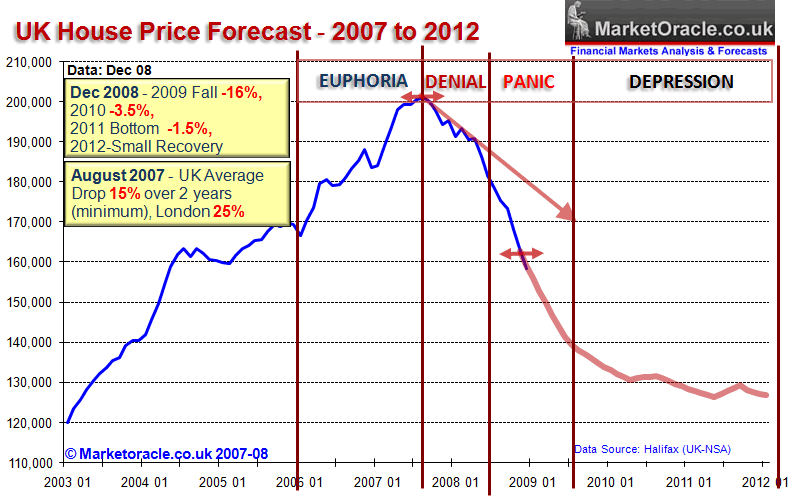
 The Bank of England is expected to keep UK interest rates on hold at 0.5% today for a fourth month. However the deep interest rate cuts have failed to lift the economy out of recession, hence the reason why the Bank of England has detonated the monetary policy equivalent of a nuclear bomb in the form of Quantitative Easing, printing £125 billion of electronic money primarily to monetize government debt to help finance the huge annual budget deficit that is mushrooming towards £180 billion for 2009 alone by artificially keeping longer term interest rates lower.
The Bank of England is expected to keep UK interest rates on hold at 0.5% today for a fourth month. However the deep interest rate cuts have failed to lift the economy out of recession, hence the reason why the Bank of England has detonated the monetary policy equivalent of a nuclear bomb in the form of Quantitative Easing, printing £125 billion of electronic money primarily to monetize government debt to help finance the huge annual budget deficit that is mushrooming towards £180 billion for 2009 alone by artificially keeping longer term interest rates lower.